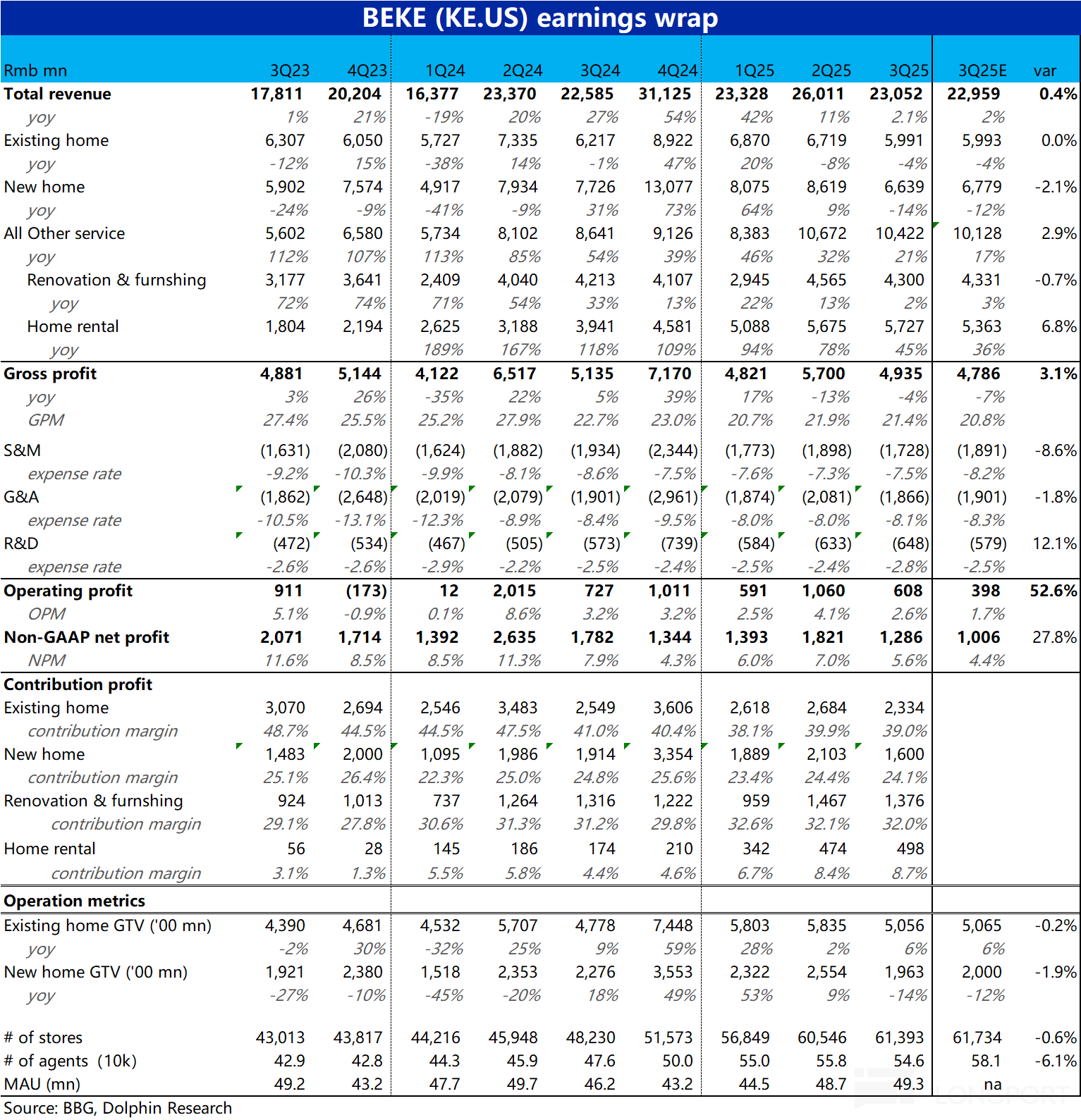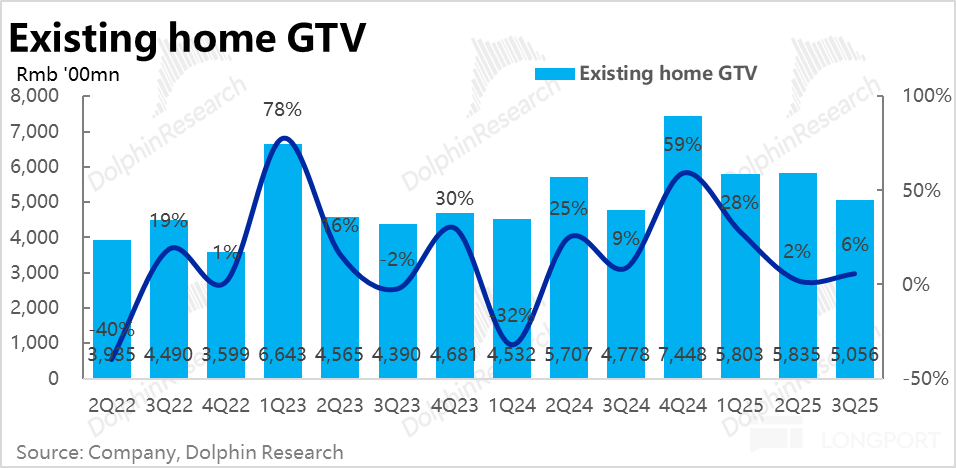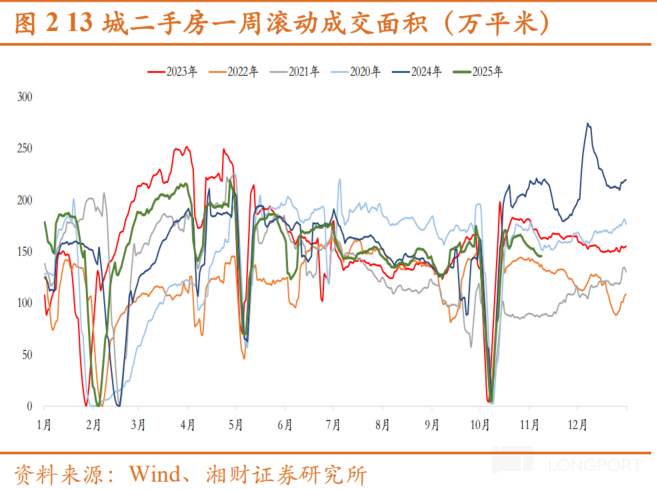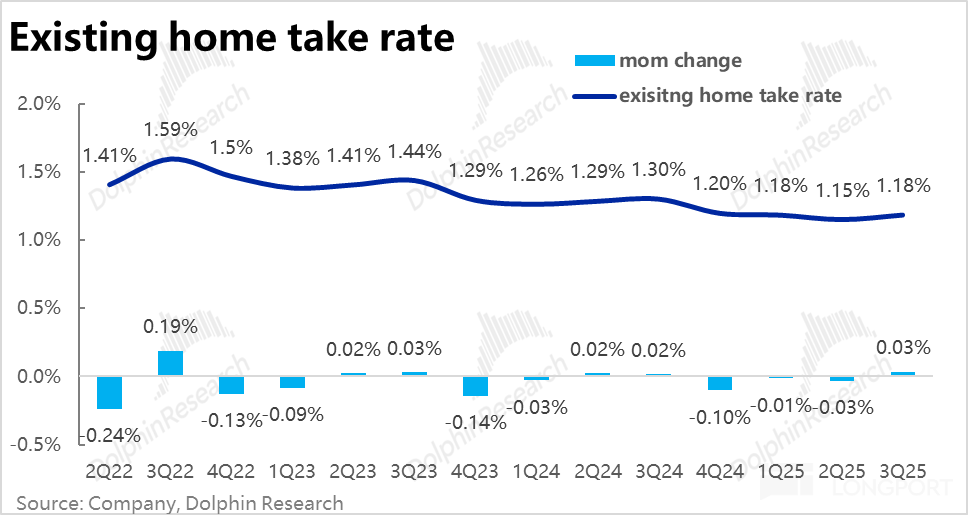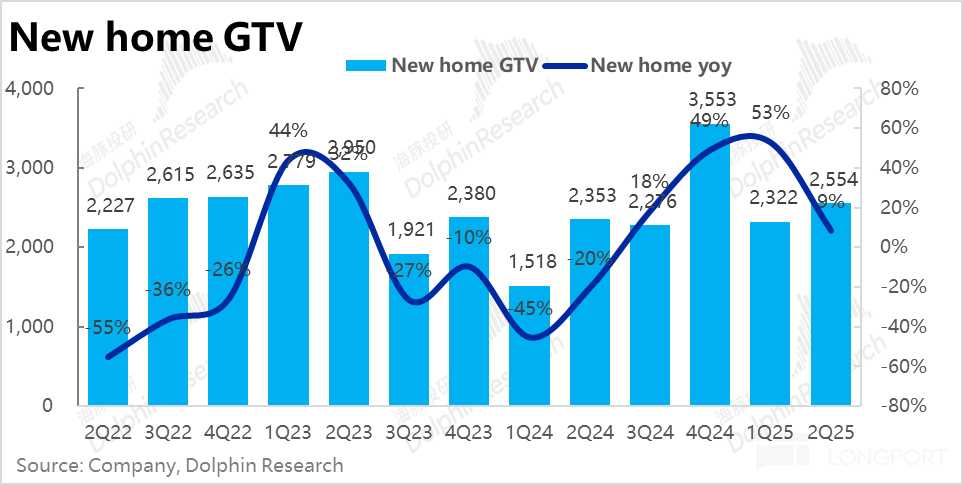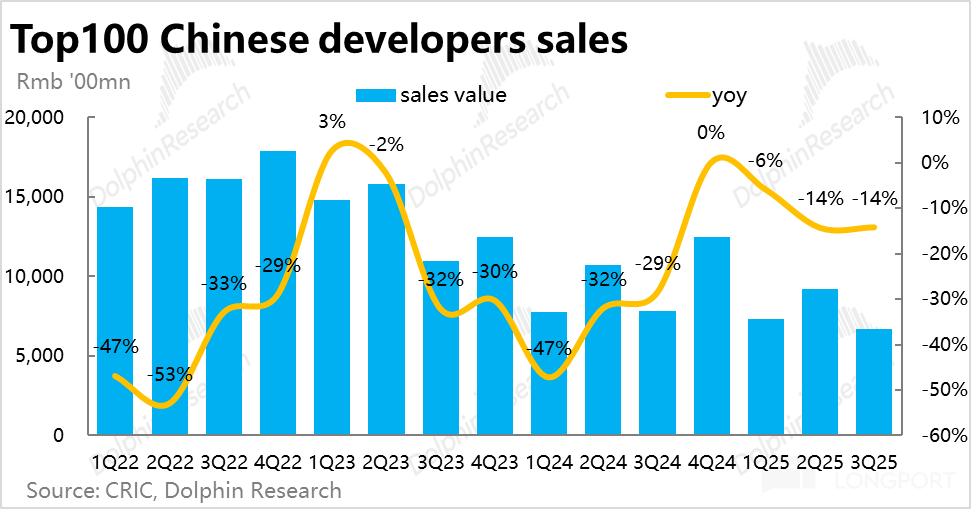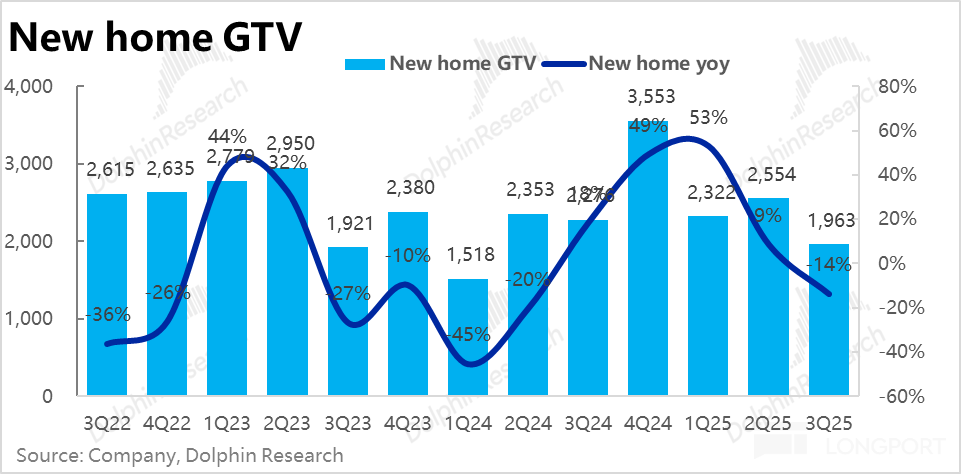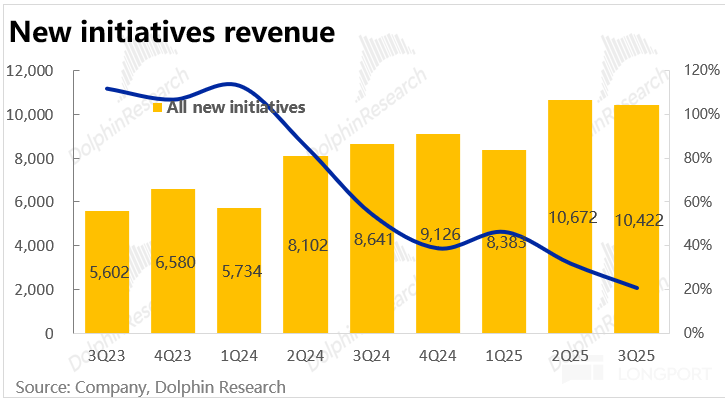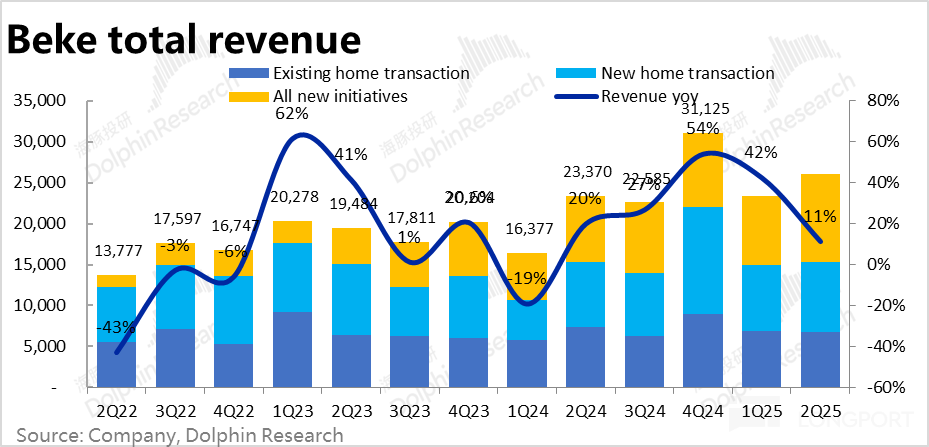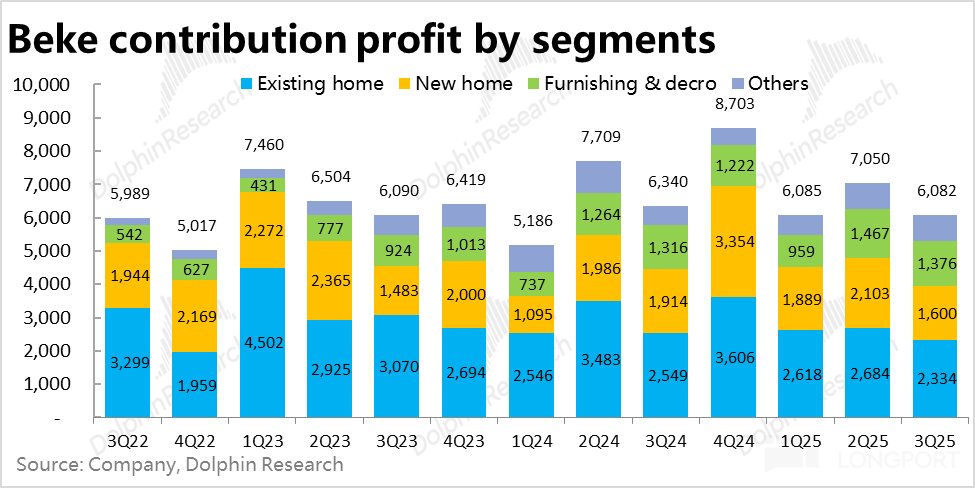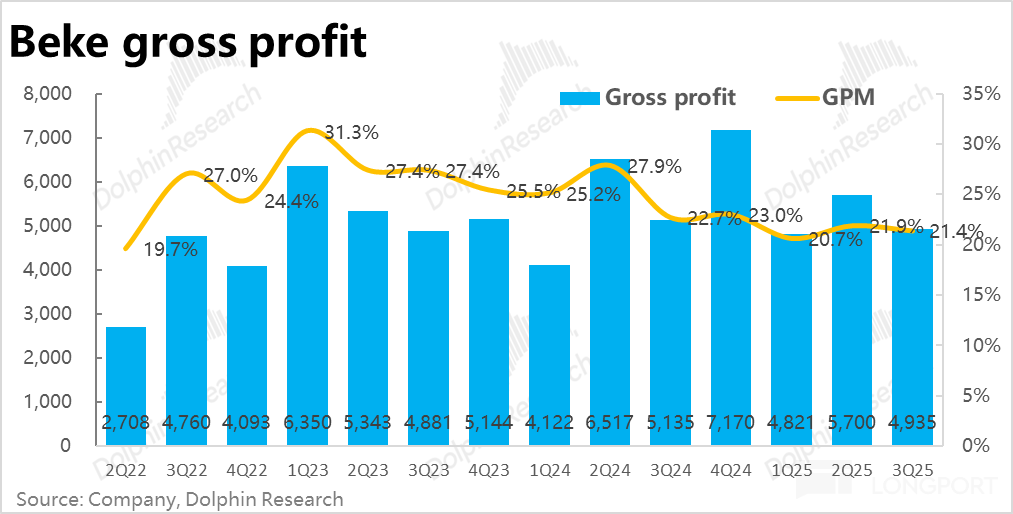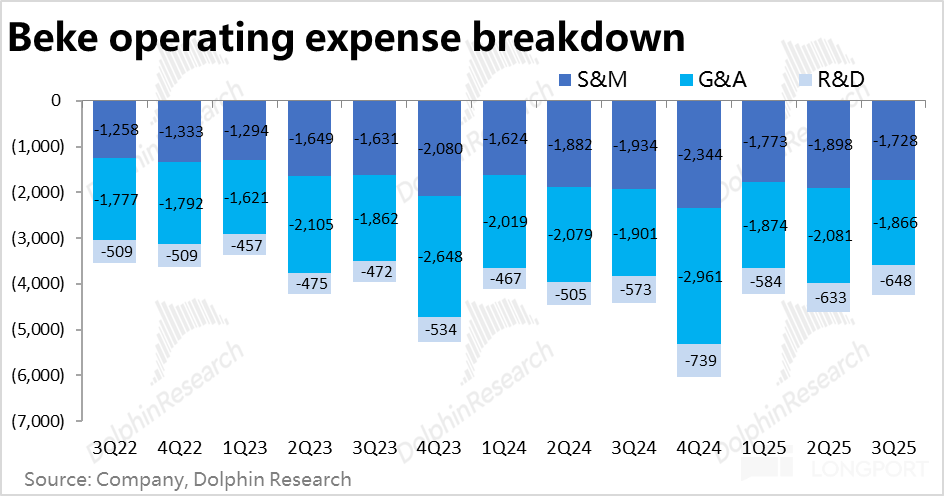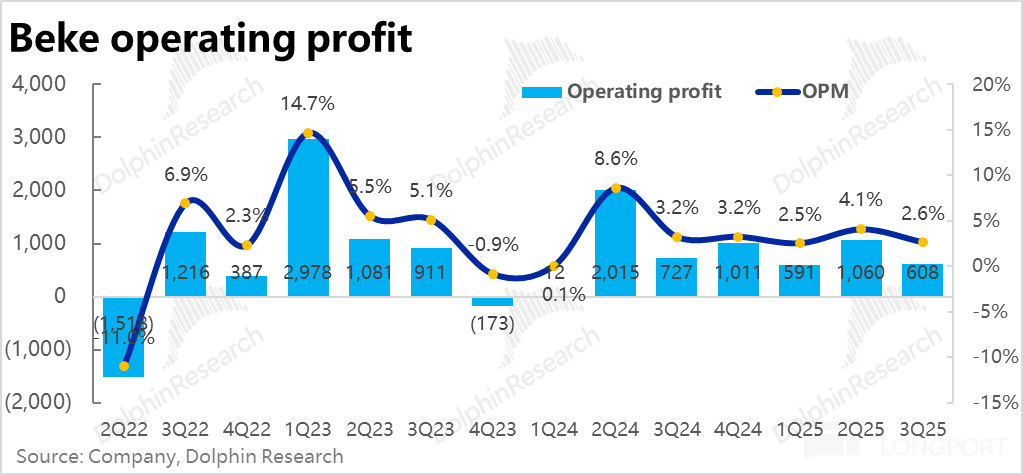
BEKE: Is there still hope?

Leading domestic housing intermediary -- $KE(BEKE.US) announced its Q3 2025 earnings before the U.S. stock market opened on November 10. Overall, the performance can be summarized as "not good, but not as bad as feared." Given the recent significant pullback in the company's stock price, which implied low expectations, the stock price has somewhat rebounded. Specifically:
1. Revenue still supports, but profits are deeply underwater: In terms of overall performance, although the core intermediary business revenue experienced negative growth in a sluggish real estate market, thanks to the strong performance of the slightly "bloated" leasing business, Beike's total revenue for the quarter still managed to maintain a 2% positive growth, roughly in line with expectations.
However, in terms of profit, due to the decline in operating leverage of the larger core intermediary business, profit margins have decreased. Although the profit margin of the new second channel business has slightly increased, the company's adjusted net profit was 1.29 billion, a decrease of about 500 million year-on-year (-28%). Even with negative growth in expenses, it could not offset the drag of declining operating scale. However, compared to the market's lower expectation of 1.01 billion profit, it is still significantly better.
2. By segment, the core of the core existing home business saw GTV maintain a 6% year-on-year growth, mainly due to more favorable measures such as easing purchase restrictions in first-tier cities.
However, due to the increasing proportion of transaction volume dominated by franchised stores, the comprehensive realization rate of existing homes still declined year-on-year (the good news is that from a quarter-on-quarter perspective, the realization rate has stabilized and rebounded), resulting in existing home revenue falling into negative growth (-4% yoy).
3. In contrast, the new home market is under greater pressure, with GTV shrinking by 14% year-on-year, slightly higher than expected. Meanwhile, compared to the sales of the top 100 real estate companies, Beike did not outperform the industry this quarter.
In terms of revenue, similar to the existing home business, the comprehensive realization rate of the new home business also saw a slight year-on-year decline (1bps), but from a quarter-on-quarter perspective, it has stabilized and rebounded. Therefore, new home business revenue declined by 14% year-on-year, consistent with the GTV decline.
4. The second channel played a "timely help" role this quarter, with revenue growing by 21% year-on-year, maintaining the group's positive revenue growth for the quarter. Among them, the more important home decoration business revenue grew by only 2% year-on-year, failing to achieve independent growth against the trend.
The leasing business revenue grew by 45% year-on-year this quarter, significantly outperforming market expectations, likely due to the rapid growth in the number of properties managed by Beike under the "Hassle-Free Rent" model.
However, since the gross profit margin contribution of the leasing business is the lowest among all major businesses (less than 9%), it has a significant contribution to revenue but not to profit.
5. By segment, the contribution profit margin of the first channel intermediary business declined year-on-year this quarter (the realization rate is still declining), while the contribution profit margin of the second channel leasing business improved year-on-year, but unfortunately, the first channel and home decoration business account for the majority of profits, resulting in the group's overall contribution gross profit margin declining by 1.7pct year-on-year.
Ultimately, Beike's overall gross profit for the quarter was 5.7 billion, down 4% year-on-year, further deteriorating compared to revenue that can still maintain positive growth (fortunately, market expectations were lower, and actual gross profit was about 3pct higher than expected).
6. Facing the harsh industry environment and growth pressure, Beike understandably took cost control measures to alleviate the pressure of profit decline. Operating expenses for the quarter decreased by about 2% year-on-year. Among them, marketing expenses (-11%) and management expenses both decreased year-on-year, but R&D expenditure still maintained a 13% positive growth.
However, despite some hedging, the market focuses more on the adjusted net profit, which was 1.29 billion this quarter, a year-on-year decline of about 500 million (-28%), larger than the decline in GAAP operating profit. This is mainly due to less confirmed SBC and more one-time gains. Overall, the reduction in business scale and revenue is an overwhelming issue.

Dolphin Research View:
As can be seen from the above analysis, from an absolute perspective, Beike's performance this quarter is undoubtedly quite poor. Although the company managed to maintain positive revenue growth with the unexpected performance of the leasing business in new businesses, trying to reduce reliance on intermediary business, the first channel business still creates 65% of the company's overall contribution profit, remaining the undisputed core of the company.
Therefore, facing the basic fading of policy stimulus effects and the lack of new policy relay, the domestic real estate market has turned cold again, and even the absolute leader is unable to resist the "heavy" macro pressure. Facing the decline in scale effect, even though the company has taken measures to control costs and optimize the number of free stores/agents to hedge, for Beike, whose profit margin is already very low (adjusted net profit margin is only a single digit%), it is "an unbearable burden."
As emphasized in the previous quarter's financial report, Beike's labor-intensive and performance-heavy business model fundamentally determines that when business scale and order density decline (the transaction volume created by single stores and single agents calculated this quarter both declined by more than 15% year-on-year), it is difficult for the company to solve everything by controlling costs. Only by improving the realization rate or reducing the commission ratio for agents can it be completely hedged to maintain profitability. However, in the current market and policy environment, improving realization or reducing the commission ratio faces significant public opinion and business pressure.
And since there are not many policy tools available, and the company is gradually entering the high base period of last year, the performance pressure Beike faces in Q4 is likely to be at least no less than this quarter. Recent high-frequency data also verifies this.
Currently, based on achieving an adjusted net profit of about 5.8 billion in 2025, Beike's market value before the performance corresponds to a PE valuation of about 22x~23x. Although profit expectations continue to be revised downwards, the recent stock price pullback has fully priced this in. Therefore, after this better-than-expected performance, the stock price can instead recover somewhat.
Therefore, from the current price, whether Beike still has significant downside space, Dolphin Research believes it may not. But the more important issue is that, as there is currently no fundamental improvement in the domestic real estate market, and no obvious short- to medium-term opportunity for Beike to rise significantly.
Detailed Interpretation of This Quarter's Financial Report:
I. Existing Homes Can Still Support, But Revenue Has Also Turned Negative
The core of the core existing home business had a GTV of 505.6 billion this quarter, growing 6% year-on-year, performing relatively more resiliently than new homes, mainly due to the favorable policies of further easing purchase restrictions in first-tier cities (exchanging price for volume). However, from high-frequency data, since October, as the benefits of the previous round of stimulus have basically faded, and there is no further policy relay, as shown in the figure below, the second-hand transaction volume in the 13 cities counted has begun to fall below 2023 and 2020, with a huge gap compared to the peak in 2024. Looking ahead to Q4, the pressure will be more evident.


By channel, this quarter franchise channels still outperformed Lianjia's self-operated channels. Among them, GTV led by Lianjia has already declined by about 2% year-on-year this quarter. (This should be partly attributed to Lianjia's active streamlining of stores and agent numbers, intending to improve store sales/agent efficiency and optimize profit structure). Meanwhile, GTV led by franchised stores grew by 11.4% year-on-year.
Due to the above-mentioned business structure changes, this quarter's comprehensive realization rate of existing homes declined year-on-year, leading to a 4% year-on-year decrease in business revenue, roughly in line with expectations. But perhaps the more critical trend is that from a quarter-on-quarter perspective, the realization rate has shown signs of stabilizing and rebounding. Facing a more difficult industry outlook, the company may no longer be willing to make too many concessions on commission rates.


II. Greater Pressure on New Home Business, Decline Exceeds 10%
In contrast, new home sales are more sluggish, with GTV declining by 14% year-on-year this quarter, slightly higher than the market's expected decline by about 2pct. Compared to the sales data of the top 100 real estate companies published by CRIC, Beike did not outperform the industry in the new home business this quarter. Similarly, in October, the year-on-year decline in new home sales of the top 100 real estate companies significantly expanded to nearly 42%, and the pressure on new home sales in Q4 will also be greater.


In terms of realization, similar to existing homes, the comprehensive realization rate of the new home business, although still slightly declining year-on-year, has stabilized and rebounded from a quarter-on-quarter perspective. Therefore, new home business revenue declined by about -14% year-on-year, without further amplification compared to the GTV decline.


III. Leasing Outperforms Expectations, Maintains Group's Positive Revenue Growth
With the core first channel business dragged down by the industry and falling into negative growth, the second channel's other businesses played a "timely help" role this quarter. The second channel's total revenue reached 10.4 billion this quarter, with a year-on-year growth rate of 21%, maintaining the group's positive revenue growth for the quarter.
Specifically, the most important home decoration business still performed poorly, with revenue growing by only 2% year-on-year this quarter. It is evident that in the context of the overall low prosperity of the real estate market, Beike's home decoration business cannot achieve independent growth against the industry's adverse conditions.
The main contributor is the leasing business, which continues to grow rapidly, with revenue growing by 45% year-on-year this quarter, significantly outperforming the market expectation of 36%. According to the company's explanation and market research, it is likely due to the rapid growth in the number of properties managed by Beike under the "Hassle-Free Rent" model. (However, the profit contributed by the leasing business is relatively low, less than half of the home decoration business, so the revenue it contributes is somewhat inflated).
With the help of the slightly "bloated" revenue from the leasing business, Beike's total revenue for the quarter was 23 billion, growing by 2% year-on-year, roughly in line with market expectations.


IV. Improvement in Second Channel Profit Margin Insufficient to Offset Deterioration in Core First Channel
By segment, how does the profit performance look? In summary, the contribution profit margin of the first channel intermediary business declined year-on-year, but has largely stabilized from a quarter-on-quarter perspective, while the contribution profit margin of the second channel business improved year-on-year, partially offsetting the "deficit" in profits from the first channel business. However, since the first channel business accounts for a larger proportion, the group's overall contribution gross profit margin is still declining both year-on-year and quarter-on-quarter.
Specifically:
1) As mentioned earlier, since the comprehensive realization rate of both existing homes and new home businesses declined slightly year-on-year this quarter, the contribution gross profit margin of these two businesses also declined year-on-year, which is not surprising.
What is slightly surprising is that from a quarter-on-quarter perspective, the realization rate of existing homes and new home businesses actually stabilized and rebounded this quarter, but the contribution gross profit margin still declined quarter-on-quarter, indicating that the commission ratio given to employees this quarter has increased.
The contribution gross profit of existing homes and new home businesses declined by 8.4% and 16.4% year-on-year, respectively, which is larger than the revenue decline. This still reflects the diseconomies of scale after business contraction.
2) Within the second channel, the home decoration business, with slowing growth, also saw a slight quarter-on-quarter decline in contribution profit margin by 0.1pct, but from a year-on-year perspective, it still improved, so it is not a drag on overall profit. Meanwhile, the leasing business, while growing rapidly, continued to improve its profit margin, rising by 0.4pct quarter-on-quarter this quarter.
The contribution gross profit of the home decoration and leasing businesses grew by about 4.5% and 86% year-on-year, partially offsetting the decline in contribution profit from the first channel business.


V. Although Cost Control Provides Some Offset, It Cannot Reverse the Diseconomies of Scale from Business Decline
From the perspective of costs and expenses, the factors affecting profit performance this quarter:
1) Firstly, due to the aforementioned greater impact of the decline in the contribution gross profit margin of the first channel business compared to the contribution of new business profit margins, the company's overall gross profit margin for the quarter was 21.4%, declining both year-on-year and quarter-on-quarter. Therefore, the actual gross profit was 5.7 billion, down 4% year-on-year, further deteriorating compared to revenue that can still maintain positive growth.
However, the market expected a lower gross profit margin, and the actual value was still slightly higher by 0.6pct than expected.

Facing the harsh industry environment and growth pressure, Beike understandably took cost control measures to alleviate the pressure of profit decline. Operating expenses for the quarter decreased by about 2% year-on-year. Specifically, marketing and management expenses both decreased year-on-year, with marketing expenses decreasing by about 11% year-on-year. Only R&D expenditure still maintained a relatively high (13%) positive growth.
Due to a year-on-year decrease of about 2 billion in gross profit, while expense savings amounted to about 0.8 billion year-on-year, the final operating profit was 610 million, a year-on-year decrease of about 120 million (a year-on-year decline of 20%). However, it is significantly better than the market's more conservative expectation of 1.01 billion.
Meanwhile, the market focuses more on the adjusted net profit, which was 1.29 billion this quarter, with a larger year-on-year decline of about 500 million (year-on-year -28%), mainly due to less confirmed SBC and more one-time gains under GAAP this quarter. Therefore, the profit decline under Non-GAAP is larger. The drag from the decline in operating scale is still very evident.




<End of Text>
Dolphin Research [Beike] Related Research:
Financial Report Commentary
Minutes on August 26, 2025, "Beike (Minutes): Will Eliminate and Optimize Inefficient Stores and Agents in Beijing and Shanghai"
Commentary on August 26, 2025, "Beike: The Real Estate Market Turns Cold Again, Can "Relaxing Purchase Restrictions" in Beijing and Shanghai Save the Day?"
Minutes on May 16, 2025, "Beike (Minutes): If the Real Estate Market Deteriorates in Q3, There May Be More Support Policies"
Commentary on May 16, 2025, "As Long as We Survive the "Roller Coaster" of the Real Estate Market, Beike Will Be Fine"
Commentary on March 19, 2025, "The Real Estate Market is Booming, But Beike Only Makes "Noise" Without Profits?"
Minutes on March 19, 2025, "Beike (Minutes): Existing Homes Continue to Recover in 2025, New Homes May Still Adjust"
Conference Call on November 23, 2024, "Beike: How Strong is the Real Estate Market Recovery After September?"
Financial Report Commentary on November 23, 2024, "Beike: Q3 "Failed," Will Tomorrow Be Better?"
Conference Call on August 13, 2024, "Beike: How Are the Home Decoration and Leasing Businesses Progressing?"
Financial Report Commentary on August 13, 2024, "Can "One Body, Three Wings" Help Beike Soar Again?"
Conference Call on May 26, 2024, "Beike: Second-Hand Homes Show Year-on-Year Improvement Trend, New Homes Continue to Be Under Pressure"
Financial Report Commentary on May 26, 2024, ""Strong Medicine to Cure Severe Illness," Can Beike Be Saved?"
Conference Call on March 15, 2024, "Even if the Real Estate Market is Frozen, Dividends Provide a Cushion"
Financial Report Commentary on March 15, 2024, "Beike: High-Quality Development of New Business"
In-Depth
June 30, 2022, "The Real Estate Market is Reviving, Can Beike Take Big Strides Again?"
December 27, 2021, "Is the Real Estate Market Warming Up? Should You Buy Beike? Wait a Little Longer"
December 15, 2021, "From "Revolutionizing Others" to "Being Revolutionized," Can Beike Withstand It?"
December 9, 2021, "The "Rebellious" Beike: Whose Life Did It Revolutionize, and Whose Savior Is It?"
Risk Disclosure and Statement of This Article:Dolphin Research Disclaimer and General Disclosure
The copyright of this article belongs to the original author/organization.
The views expressed herein are solely those of the author and do not reflect the stance of the platform. The content is intended for investment reference purposes only and shall not be considered as investment advice. Please contact us if you have any questions or suggestions regarding the content services provided by the platform.


